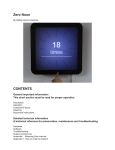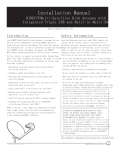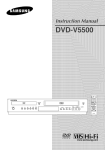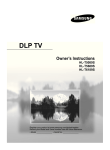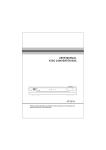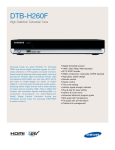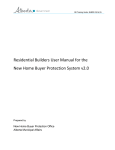Download digital set top box
Transcript
DTB-H260F DIGITAL SET TOP BOX Samsung Electronics America inc. SERVICE DIVISION 400 Valley Road, Suite 201 Mount Arlington, NJ 07856 1-800-SAMSUNG (1-800-726-7864) www.samsungusa.com Owner’s Instructions Made under one or more of the following US patents; 6,480,239; 6,243,431; 6,192,090; 6,184,938; 6,133,964; 5,659,372; 5,479,449 MF68-00414A-00 1 2006-10-12 ソタネト 1:13:05 Warning! Important Safety Instructions CAUTION RISK OF ELECTRIC SHOCK DO NOT OPEN CAUTION: TO REDUCE THE RISK OF ELECTRIC SHOCK, DO NOT REMOVE COVER (OR BACK). NO USER SERVICEABLE PARTS INSIDE. REFER SERVICING TO QUALIFIED SERVICE PERSONNEL. Thank You for Choosing Samsung Thank you for choosing Samsung! Your new Samsung Digital TV receiver represents the latest in DTV IRD technology. We designed it with easy-to-use on-screen menus and closed captioning capabilities, making it one of the best products in its class. We are proud to offer you a product that will provide convenient, dependable service and enjoyment for years to come. Important Safety Information Always be careful when using your product. To reduce the risk of fire, electrical shock, and other injuries, keep these safety precautions in mind when installing, using, and maintaining your machine. • Read all safety and operating instructions before operating your product. This symbol indicates high voltage is present inside. It is dangerous to make any kind of contact with any inside part of this product. • Keep the safety and operating instructions for future reference. • Heed all warnings on the product receiver and in the operating instructions. • Follow all operating and use instructions. This symbol alerts you that important literature concerning operation and maintenance has been included with this product. Note to CATV system installer: This reminder is provided to call CATV system installer’s attention to Article 820-40 of the National Electrical Code (Section 54 of Canadian Electrical Code, Part I), that provides guidelines for proper grounding and, in particular, specifies that the cable ground shall be connected to the grounding system of the building as close to the point of cable entry as practical. Caution: FCC regulations state that any unauthorized changes or modifications to this equipment may void the user’s authority to operate it. Caution: To prevent electric shock, match the wide blade of plug to the wide slot, and fully insert the plug. Attention: pour eviter les chocs electriques, introduire la lame le plus large de la fiche dans la borne correspondante de la prise et pousser jusqu’au fond. Important: One Federal Court has held that unauthorized recording of copyrighted TV programs is an infringement of U.S. copyright laws. Certain Canadian programs may also be copyrighted and any unauthorized recording in whole or in part may be in violation of these rights. Warning-To prevent damage which may result in fire or electric shock hazard, do not expose this appliance to rain or moisture. • Unplug the product from the wall outlet before cleaning. Use a damp cloth; do not use liquid or aerosol cleaners. • Never add any attachments and/or equipment without approval of the manufacturer. Such additions can increase the risk of fire, electric shock, or other personal injury. • Do not use the product where contact with or immersion in water is a possibility, such as near bath tubs, sinks, washing machines, swimming pools, etc. • Do not place the product on an unstable cart, stand, tripod, bracket, or table where it can fall. A falling product can cause serious injury to a child or adult, and serious damage to the appliance. Use only with a cart, stand, tripod, bracket, or table recommended by the manufacturer or sold with the product. Follow the manufacturer’s instructions when mounting the unit, and use a mounting accessory recommended by the manufacturer. Move the product and cart with care. Quick stops, excessive force, and uneven surfaces can make the unit and cart unsteady and likely to overturn. • Provide ventilation for the product. The unit is designed with slots in the cabinet for ventilation to protect it from overheating. Do not block these openings with any object, and do not place the product on a bed, sofa, rug, or other similar surface. Do not place it near a radiator or heat register. If you place the product on a rack or bookcase, ensure that there is adequate ventilation and that you’ve followed the manufacturer’s instructions for mounting. • Operate your product only from the type of power source indicated on the marking label. If you are not sure of the type of power supplied to your home, consult your appliance dealer or local power company. • Use only a grounded or polarized outlet. For your safety, this product is equipped with a polarized alternating current line plug having one blade wider than the other. This plug will fit into the power outlet only one way. If you are unable to insert the plug fully into the outlet, try reversing the plug. If the plug still does not fit, contact your electrician to replace your outlet. 2 2-3 3 2006-10-12 ソタネト 1:13:05 • Protect the power cord. Power supply cords should be routed so that they won’t be walked on or pinched by objects placed on or against them. Pay particular attention to cords at plugs, convenience receptacles, and the point where they exit from the unit. • Unplug the product from the wall outlet and disconnect the antenna or cable system during a lightning storm or when left unattended and unused for long periods of time. This will prevent damage to the unit due to lightning and power-line surges. • Avoid overhead power lines. An outside antenna system should not be placed in the vicinity of overhead power lines or other electric light or power circuits or where it can fall into such power lines or circuits. When installing an outside antenna system, be extremely careful to keep from touching the power lines or circuits. Contact with such lines can be fatal. • Do not overload the wall outlet or extension cords. Overloading can result in fire or electric shock. • Do not insert anything through the openings in the unit, where they can touch dangerous voltage points or damage parts. Never spill liquid of any kind on the product. • Ground outdoor antennas. If an outside antenna is connected to the product, be sure the antenna is grounded so as to provide some protection against voltage surges and built-up static charges. Section 810 of the National Electrical Code, ANSI/NFPA No.70-1984, provides information about proper grounding of the mast and supporting structure, grounding of the lead-in wire to an antenna discharge unit, size of grounding conductors, location of antenna discharge unit, connection to grounding electrodes, and requirements for the grounding electrode. ����������� ����������������� ������� ������������ ������������ �������� ������� ��������� ������� �������������� �������������������� ��������� ���������� �������������������� This device complies with part 15 of the FCC Rules. Operation is subject to the following two conditions: (1) This device may not cause harmful interference, and (2) This device must accept any interference that may cause undesired operation. This television receiver provides display of television closed captioning in accordance with §15.119 of the FCC rules. NOTES This equipment has been tested and found to comply with the limits for a Class B digital device, pursuant to part 15 of the FCC Rules. These limits are designed to provide reasonable protection against harmful interference in a residential installation. This equipment generates, uses and can radiate radio frequency energy and, if not installed and used in accordance with the instructions, may cause harmful interference to radio communications. However, there is no guarantee that interference will not occur in a particular installation. If this equipment dose cause harmful interference to radio or television reception, which can be determined by turning the equipment off and on, the user is encouraged to try to correct the interference by one or more of the following measures: • Reorient or relocate the receiving antenna. • Increase the separation between the equipment and receiver. • Connect the equipment into an outlet on a circuit different from that to which the receiver is connected. ������������� ������������������������������ ����������������������� ���������������� ��������������������� • Do not attempt to service the product yourself. Refer all servicing to qualified service personnel. Unplug the unit from the wall outlet and refer servicing to qualified service personnel under the following conditions: - when the power-supply cord or plug is damaged - if liquid has been spilled on the unit or if objects have fallen into the unit - if the product has been exposed to rain or water - if the product does not operate normally by following the operating instructions - if the product has been dropped or the cabinet has been damaged - when the product exhibits a distinct change in performance • If you make adjustments yourself, adjust only those controls that are covered by the operating instructions. Adjusting other controls may result in damage and will often require extensive work by a qualified technician to restore the product to normal. • When replacement parts are required, be sure the service technician uses replacement parts specified by the manufacturer or those that have the same characteristics as the original part. Unauthorized substitutions may result in additional damage to the unit. • Upon completion of any service or repairs to this product, ask the service technician to perform safety checks to determine that the product is in a safe operating condition. 4 4-5 5 2006-10-12 ソタネト 1:13:05 A Guide to Digital TV What is Digital Television? Digital television (DTV) is a new way of transmitting high quality video and audio to your TV set. Using DTV, broadcasters can transmit high definition TV (HDTV) images, Dolby digital surround audio, and new services such as multicasting (transmitting more than one program on the same TV channel) and datacasting (providing electronic program guides and interactive television). Several of these services can be combined into a single digital broadcast. Digital Television Services How to View Digital Television There are three ways to watch DTV. The first is to use an integrated digital TV; one with a built-in digital television tuner. The second is to connect an external DTV set-top receiver to a DTV-ready television or monitor. This type of TV or monitor will have wideband component video and stereo audio inputs. You can also watch DTV signals with personal computer (PC) tuner cards and computer monitors. 1. Integrated TVs versus DTV-ready TVs and monitors The advantage of an integrated DTV set is that it can tune both analog and digital TV channels at the same time. All you’ll need to do is add an external antenna and you are ready to watch DTV. Digital Picture Quality However, integrated DTV sets are not as common as DTV-ready TVs and monitors. If you already own a DTV-ready TV with component video, digital visual interface (DVI) or high definition multimedia interface (HDMI) inputs, you can enjoy DTV broadcasts by simply adding a low-cost DTV set-top receiver and antenna. DTV programs are transmitted in two different formats. The first is Standard Definition Television (SDTV) and the second is High Definition Television (HDTV). 2. Using your existing analog TV set SDTV program formats include 480-line interlaced (480i) and 480-line progressive (480p) video. 480i programs are essentially a digital version of our current analog TV programs, while the 480p format offers improved image detail over 480i. Some 480p programs are broadcast in widescreen and are comparable to progressive-scan DVD movies in image quality. HDTV program formats include 1080-line interlaced (1080i) and 720-line progressive (720p). Both HDTV formats are always broadcast in widescreen, and both offer much higher picture quality than SDTV. Your analog TV set can be used to view down-converted DTV broadcasts by connecting the DTV set-top receiver to your composite (yellow RCA jack) or S-video (black circular jack) AV inputs, as well as connecting stereo audio inputs. While the picture quality won’t be as good as you’d see on a DTV-ready TV set, it will be as good or slightly better than analog TV broadcasts. Dolby Digital Sound With DTV, you can listen to a variety of Dolby Digital auto formats from Dolby Digital 2.0 to Dolby Digital 5.1 using your home audio system. Many HDTV programs are now broadcast with Dolby Digital 5.1 soundtracks. Interactive Communications and Datacasting DTV will allow you to interact with your television; choosing programs from a detailed program guide and accessing ancillary data about a program. 6 6-7 7 2006-10-12 ソタネト 1:13:06 Q&A 1. Is the antenna I use for existing TV reception good enough for DTV? Over-the-air (OTA) digital TV broadcasting uses the same channels as analog TV and works well with many existing TV antennas. However, DTV broadcast channel assignments are different from analog channels. You should find out whether your local DTV broadcasts are on VHF (channels 2-13) or UHF (channels 14-69) to see if you need a different antenna. If your DTV channels are on UHF and you already get good UHF reception, your present antenna may work fine. The same holds true for VHF DTV reception. Note that in some markets, both VHF and UHF channels are used for DTV broadcasts. You can find out the latest DTV channel assignments for your area by browsing selected Internet web sites such as www.fcc.gov. 2. How difficult is it to receive DTV signals indoors? This depends on whether your local DTV stations are running full power or not and how close your location is to the transmission tower. DTV receivers do not require as much signal as analog TV receivers to produce high-quality images and sound. Once the DTV signal level exceeds a certain threshold at the receiver, the digital video and audio data is decoded at the same quality it was originally encoded for broadcast. This is a big advantage for DTV over analog TV—there is no noise, ghosting, static, or scratchy audio. 3. How can I connect an antenna in my townhouse, co-operative apartment, condominium, or apartment? The Federal Communications Commission’s OTARD Rule (part of the Telecommunications Act of 1996) allows residents of condominiums, townhouse, or members of neighborhood associations to put up outside antennas for reception of broadcast TV signals as long as those antennas are not located in common areas and are no more than 12’ in height. Residents of rental units (apartments, etc) are not covered by the OTARD rules and will have to use indoor antennas to receive DTV broadcasts. It is possible that the landlord of an apartment complex can provide broadcast DTV signals via a master TV antenna system to each apartment. 4. Can I connect my DTV set-top receiver to my cable TV service? Cable TV systems use a different method for transmitting digital TV programs that is currently incompatible with broadcast DTV set-top receivers. So you will still need to use an outdoor or indoor antenna to receive OTA broadcast DTV programs. The good news is that you won’t have to pay a monthly or per-program charge to watch OTA DTV and HDTV programs. They’re free, unlike subscription satellite TV or premium cable TV. All you need is an antenna and a DTV set-top receiver to enjoy clear, sharp widescreen images and high-quality audio. 8 8 2006-10-12 ソタネト 1:13:06 CONTENTS Chapter 1: Connecting the Set-Top Box ................................................................. 10 Front Panel ...............................................................................................................................................10 Rear Panel ................................................................................................................................................11 Accessories ..............................................................................................................................................12 Connecting Antennas ..........................................................................................................................13 Connecting the Set-Top Box to a TV Set .......................................................................................14 Connecting an Audio Component..................................................................................................16 Chapter 2: Remote Control and On-Screen Menus ............................................... 17 Reviewing the Remote Control ........................................................................................................17 Installing the Batteries.........................................................................................................................19 Handling On-Screen Menus ..............................................................................................................20 Using the On-screen Help ..................................................................................................................21 Viewing the Information ....................................................................................................................22 Chapter 3: Operation ............................................................................................... 23 Memorizing Channels .........................................................................................................................23 Adding and Deleting Channels ........................................................................................................24 Setting Your Favorite Channels ........................................................................................................25 Changing Channels ..............................................................................................................................26 Checking the Signal Strength ...........................................................................................................27 Viewing Full Guide and Mini Guide ................................................................................................28 Scheduling to Watch Programs ........................................................................................................29 Adjusting the Volume ..........................................................................................................................30 Chapter 4: Special Features .................................................................................... 31 Setting the Local Language...............................................................................................................31 Changing the Screen Format ............................................................................................................32 Setting the Local Time .........................................................................................................................35 Setting the Sound Output .................................................................................................................36 Selecting a Multi-track Language ...................................................................................................37 Configuring the Captions-related Settings ..................................................................................38 Configuring the Rating Control........................................................................................................40 Setting the Transparency ...................................................................................................................44 Using the Menu Map ...........................................................................................................................45 Appendix .................................................................................................................. 46 Troubleshooting ....................................................................................................................................46 Specifications..........................................................................................................................................47 9 9 2006-10-12 ソタネト 1:13:06 1 1 CHAPTER ONE Connecting the Set-Top Box Front Panel CHAPTER ONE Connecting the Set-Top Box Rear Panel 1 1 2 3 4 5 6 7 8 2 IR Receiver Press to turn the power on or off. 0 ! 2 1 ANT OUT 1 9 Receives IR (Infra-red) signals from the remote control. Use to connect your TV using a coaxial cable. The received RF signals from ANT / CABLE IN are bypassed for analog channels. 2 ANT / CABLE IN Connect the AIR antenna or CATV antenna here. Connect the cable in the event that a local cable provider is passing through 8-level Vestigial Sideband (8VSB) and Quadrature Amplitude Modulation (QAM) on their systems. 3 HDMI OUT Connect the HDMI input of your display using HDMI cable. 4 Manufactured under license from Dolby Laboratories. “Dolby” and the double-D symbol are trademarks of Dolby Laboratories. Confidential unpublished works. 1992-1997 Dolby Laboratories. All rights reserved. 5 NOTE In this instruction book, the terms “Set-Top Box” and “STB” are equivalent. 6 7 8 This USB port is used for maintenance purpose only. Please, do not insert USB devices into the port. S-VIDEO OUT Provides good picture quality. If your TV has S-Video compatibility, use this jack along with the Video jacks to connect the Set-Top Box. Use this output for conventional TV sets that have an S-Video input but no component video inputs. This output port supports only the standard definition (SD) output. (OSD not supported) DTV OUT (COMPONENT) You can connect Y, PB, and PR to a TV or another video component input. As with DTV OUT, 1080i (interlaced scanning), 720p (progressive scanning), and 480p are available by setting the RESOLUTION SELECT switch. This output port supports SD and high definition (HD). VIDEO OUT If your TV has Video capability, connect this jack to the video input jack on your TV using a video cable. Use this output for conventional TV sets that do not have S-Video or component video inputs. This output port supports SD only. (OSD not supported) L/R AUDIO OUT Connect these jacks to the analog audio inputs on your TV set (i.e., to a TV that has jacks for L/R inputs). Or connect these jacks to the L/R inputs of a separate audio component. 9 DOLBY DIGITAL OUT (OPTICAL) Use to connect the Digital Audio Input on your TV set. 0 RESOLUTION SELECT Switches between 1080i, 720p, 480p, and 480i formats. Switches the DTV Component outputs to the following formats: • 1080i Use this setting for an HDTV-ready wide screen (16:9) aspect ratio TV monitor that can handle the 1080i video output format. • 720p Use this setting for an HDTV-ready wide screen (16:9) aspect ratio TV monitor that can handle the 720p video output format. • 480p Use this setting for a Digital-ready screen (4:3) aspect ratio TV monitor with Progressive Scan DTV ready component video inputs that can handle the 480p video output format. The TV monitor may be labeled Enhanced Definition or Progressive Scan, but not Wide Screen. • 480i Use this setting for a conventional TV with regular video, S-Video, or component video inputs. ! DTV OUT SELECT Use to select any of Y, PB, PR and HDMI according to the video input of the TV or monitor. NOTE The use of 1080i on a 4 x 3 monitor or the use of 480p on a 16 x 9 monitor may cause Aspect Ratio picture distortion. Check the TV monitor’s owner’s manual to verify this capability. Subscription cable services require service-specific requirements for viewing. • SD=Standard Definition (480i) HD=High Definition (480p, 720p, 1080i) 10 10-11 11 2006-10-12 ソタネト 1:13:07 1 1 CHAPTER ONE Connecting the Set-Top Box CHAPTER ONE Connecting the Set-Top Box Accessories Connecting Antennas Please make sure the following items are included with your Set-Top Box. If any items are missing, contact your dealer. This section shows how to connect a cable TV with or without a cable box, and how to connect an indoor or outdoor antenna. Remote Control (MF59-00291B) / AAA Batteries (4301-001035) Component Cable (MF39-00284A) Owner’s Instructions (MF68-00414A) 1 Indoor/Outdoor Antenna: You may need a 75Ω adaptor or a combiner, as shown in the illustration on the right. 2 Cable TV without a Cable Box: If you have a cable TV and do not use a cable box, connect the cable to ANT/CABLE IN on the rear of the Set-Top Box. 3 Cable TV with a Cable Box: If you have a cable box, connect as shown in the illustration on the right. RF Cable (AC39-42001J) Composite/Audio Cable (MF39-00286A) NOTES • If your antenna has separate leads for VHF/UHF signals, you will need to purchase a combiner and connect it as shown in the illustration above. • The Set-Top Box can receive DTV signals in the event that a local cable provider is passing 8VSB and QAM through on their system. (8VSB is the RF modulation format utilized to transmit digital bits over the airwaves to the home consumer. QAM conveys data by modulating the amplitude of two carrier waves.) • When receiving Digital Cable Signal: If your cable service signal does not comply with the ATSC requirement, this product may not operate properly. 12 12-13 13 2006-10-12 ソタネト 1:13:12 1 1 CHAPTER ONE Connecting the Set-Top Box Connecting the Set-Top Box to a TV Set Connect an antenna cable to the ANT/ CABLE IN jack on your Set-Top Box. 2 Connect the Video Cables. YPBPR format: Connect a Component video cable between the DTV OUT (COMPONENT) jacks on your Set-Top Box and the DTV INPUT jacks on the digital TV. HDMI format: Connect a HDMI cable between the HDMI OUT jack on your Set-Top Box and the HDMI INPUT jack on the digital TV. <Digital TV> 3 Connecting the Set-Top Box Digital Ready TV or Normal TV Digital TV 1 CHAPTER ONE Connect the Audio Cables. Connect an audio cable between the L/R AUDIO OUT jacks on your Set-Top Box and L/R AUDIO IN jacks on the digital TV. NOTES • You must set to Y, PB, PR with the DTV OUT SELECT switch on the rear of your Set-Top Box. • The On-Screen Display (OSD) menus are supported for DTV OUT (COMPONENT) and HDMI only. 1 Connect an antenna cable to the ANT/ CABLE IN jack on your Set-Top Box. 2 Connect the Video Cables. Digital Ready TV: Connect a Component video cable between the DTV OUT (Component) jacks on your Set-Top Box and the VIDEO INPUT jacks on TV. Or connect a HDMI cable between the HDMI OUT jack on your Set-Top Box and the HDMI INPUT jack on TV. Normal TV: Connect a video cable between the VIDEO OUT jack on your Set-Top Box and the VIDEO INPUT jack on the TV. Or connect an S-Video cable between the S-VIDEO OUT jack on your Set-Top Box and the S-VIDEO INPUT jack on the TV. 3 <Digital Ready TV> Connect the Audio Cables Digital Ready TV: Connect an audio cable between the DOLBY DIGITAL OUT (OPTICAL) jack on your Set-Top Box and the DOLBY DIGITAL IN jack on the TV. Or connect an audio cable between the L/R AUDIO OUT jacks on your Set-Top Box and L/R AUDIO IN jacks on the TV. Normal TV: Connect an audio cable between the L/R AUDIO OUT jacks on your Set-Top Box and L/R AUDIO IN jacks on the TV. < Normal TV> NOTES 14 14-15 • The TV set must be “digital compatible” (i.e., it must have appropriate audio and digital videoterminals). • The On-Screen Display (OSD) menus are supported for DTV OUT (COMPONENT) and HDMI only. • You must set to Y, PB, PR with the DTV OUT SELECT switch on the rear of your Set-Top Box. 2006-10-12 15 ソタネト 1:13:24 1 CHAPTER ONE Connecting the Set-Top Box Connecting an Audio Component There are many types of audio systems on the market today. A simplified illustration of an audio system is shown on the right. For more information, see your audio system owner’s manual. 16 16 2006-10-12 ソタネト 1:13:33 2 CHAPTER TWO Remote Control and On-Screen Menus Reviewing the Remote Control The remote control and on-screen menus work together to operate your Set-Top Box. Understanding the remote control buttons and the menus allows you to operate the Set-Top Box with ease. If you need some assistance while using the remote control and the menus, the feature that displays a help description upon selecting a menu item will be useful. 1 POWER ( ) Press to turn the power on or off. 2 ANTENNA Press to switch to Air or Cable. 3 FAV.CH Press to go to the Favorite Channel List. 1 2 3 4 4 NUMERIC Buttons Press to input numbers or to go directly to a specific channel. 5 6 8 7 9 0 ! 5 – (Hyphen) Use to input a minor digital channel with the NUMERIC buttons. 6 PRE.CH Press to go to the previous channel. 7 VOL +/- Press to increase or decrease the volume. 8 (MUTE) Press to mute the volume. / Press to move the channel upward or downward. 9 CH ) Press to display the on-screen menu or switch back to the previous menu screen. This button works only when the COMPONENT jacks are properly connected. The RCA cable connection cannot support the on-screen menu display. 0 MENU ( ! EXIT ( ) Press to exit from the on-screen menu or a pop-up display. 17 17 2006-10-12 ソタネト 1:13:34 2 2 CHAPTER TWO Remote Control and On-Screen Menus CHAPTER TWO Remote Control and On-Screen Menus Installing the Batteries @ ARROW Buttons (///) Use to move the on-screen cursor up, down, left, or right. Remove the battery cover on the back of your remote control as shown below. Put two AAA batteries into the compartment and close the cover. ) While using the on-screen menus, press this button to confirm the selected menu option. # ENTER ( $ COLOR Buttons (RED/GREEN/YELLOW/ BLUE) Use these buttons to activate functions as displayed on the menu. % GUIDE Press to display the Electronic Program Guide (EPG). ^ CH.LIST Press to go to the Channel List. & FREEZE Press to freeze the current on-screen image. This is implemented by stopping the decoding action. * INFO ( ) Press to display information on the current channel. ( ASPECT Press to display or change the current aspect ratio. @ # % ^ ( ) $ & * a b ) TIMER Press to go to the scheduled list. a CAPTION Press to display or change the current caption setting. b MTS Press to display or change the current multi track sound (MTS) language. One or more languages might be available depending on the service provider. 18 18-19 19 2006-10-12 ソタネト 1:13:35 2 CHAPTER TWO Remote Control and On-Screen Menus 2 CHAPTER TWO Remote Control and On-Screen Menus Handling On-Screen Menus Using the On-screen Help To go to the On-Screen Menu, press the MENU ( ) button. Using the ARROW (///) buttons in the center of your remote control, you can move between menus. To enter a specific menu, press the ENTER ( ) button. You can select a menu or confirm a selected option using this button. To go back to the previous menu from a sub-menu, press the MENU ( ) button or select Return on the current menu screen. To exit from the On-Screen Menu, press the EXIT ( ) button. If you want to see the description of each selected menu, use the On-screen Help feature. Main-menu To turn the on-screen help on: 1 Press the MENU ( 2 Use the / buttons to select the Preference menu and press the ENTER ( ) button. ) button on your remote control. Use the / buttons to select Help and press the ENTER ( ) button. <Example of “Guide” menu> 3 Use the / buttons to select “On.” Press the ENTER ( ) button and the on-screen help feature applies. When you move the cursor using the / buttons, you can see the description of each menu at the top of the On-Screen Menu. Sub-menu To turn the on-screen help off: Use the / buttons to select “Off” and press the ENTER ( The on-screen help disappears. ) button. <Example of “Full Guide” sub-menu> NOTE The On-Screen Menu is displayed only when the COMPONENT jacks or HDMI jack on the rear of your Set-Top Box are properly connected. 20 20-21 21 2006-10-12 ソタネト 1:13:37 2 CHAPTER TWO Remote Control and On-Screen Menus Viewing the Information You can view information on the current channel by pressing the INFO ( ) button. The INFO shows: • The major channel number and the minor channel number if you are viewing a digital channel. (e.g. DTV 6-1; 6 is major channel number and 1 is minor channel number) • Current time and date. (See page 35) • Program title and other information if available. • The current program’s rating. • Broadcast format of current program. For example, 1080i, 720p, etc. (See page 11) • Multi-track languages available for the current program. For example, English, Spanish, etc. (See page 37) • Sound output; PCM or Dolby Digital To hide INFO: Press the INFO ( ) button again or press the EXIT ( the information will automatically disappear. ) button. After 10 seconds, 22 22 2006-10-12 ソタネト 1:13:39 3 CHAPTER THREE Operation Memorizing Channels Before you can use any of the special channel buttons (CH use must be scanned for available channels. 1 2 Press the MENU ( / , FAV.CH, PRE.CH), the antenna you wish to ) button on your remote control. Use the / buttons to select the Channel menu and press the ENTER ( ) button. Use the / buttons to select Auto Program and press the ENTER ( ) button. 3 Use the / buttons to select an antenna and press the ENTER ( ) button. “Auto Channel in Progress.” will be displayed while your available channels are scanned. Upon completion, your Set-Top Box will store all the available scanned channels. NOTES • Your Set-Top Box MUST be connected to an antenna in order to receive digital TV signals. • Even if a specific channel is removed from the memory, you can always tune to that channel directly by using the NUMERIC buttons on your remote control. • If you wish to stop scanning in the middle of the scanning process, press the ENTER ( ) button to select the stop command, and then press the ENTER ( ) button to select OK. • If you have changed the connected antenna, use the ANTENNA button on your remote control to change the selected antenna after scanning completes. 23 23 2006-10-12 ソタネト 1:13:40 3 3 CHAPTER THREE Operation Setting Your Favorite Channels To add channels that were not memorized (or to delete unwanted channels from the memory). You can create a list to easily navigate your Favorite Channels. Enter the digits of the channel to be added or deleted. Press the MENU ( ) button on your remote control. Use the / buttons to select the Channel menu and press the ENTER ( ) button. Use the / buttons to select Channel Manager and press the ENTER ( ) button. The Channel Manager screen will appear. You can also go to this screen directly by pressing the CH.LIST button. 4 Select a channel you want to add or delete and press the ENTER ( ) button. You can find editing options such as Watch, Add, Delete, and Favorite. 5 Select Add or Delete from the option list. The selected channel will now be added or deleted from the Channel List. NOTES 24-25 Operation Adding and Deleting Channels 1 2 3 24 CHAPTER THREE • When a channel has been added, you are able to tune to the channel with the CH / buttons. • When a channel has been deleted, you must enter the channel number in using the numeric button to tune to it. You will no longer be able to tune to the channel using the CH / buttons. • The check-mark ( ) means the channel is included in the list. • If you are not sure of which antenna to select, choose Air+Cable to scan all possible antennas and channels. • You can change the mode using the RED button. • Even if the channel is deleted, you can tune to it directly using the NUMERIC buttons. • Even if the channel is deleted, the channel will still be displayed, however it will be disabled. • Even if the channel is deleted, the channel will be displayed in the Added List in case you are currently watching it. 1 2 3 Press the MENU ( ) button on your remote control. Use the / buttons to select the Channel menu and press the ENTER ( ) button. Use the / buttons to select Channel Manager and press the ENTER ( ) button. The Channel Manager screen will appear. You can also go to this screen directly by pressing the CH.LIST button. Select a channel you wish to add and press the ENTER ( ) button. Select Favorite in the displayed menu. The channel is added into the Favorite Channel List. Select Favorite on a channel already listed as a Favorite will remove it from your Favorite List. The favorite channel is distinguished with the heart-mark ( ). NOTES • Channels must first be memorized before they can be set as favorite channels. (See page 23) • When a channel has been added into the Favorite Channel List, you can reach the channel using the FAV.CH buttons. • When multiple channels are registered in the Favorite Channel List, you can step through your favorite channels by pressing the FAV.CH button. • Even if the current channel is not a favorite channel, it will still be displayed in the Favorite Channel List. 25 2006-10-12 ソタネト 1:13:43 3 CHAPTER THREE Operation 3 CHAPTER THREE Operation Changing Channels Checking the Signal Strength You can change the currently displayed channel with the following methods: Unlike analog channels, which can vary in reception quality from “snowy” to “clear,” the signal strength in digital channels is graphically displayed as explained below. Unlike analog channels, you cannot fine-tune a digital channel. NUMERIC buttons Press the NUMERIC buttons (0–9) to directly enter the channel number. NOTE When the channel you have selected contains two or more minor channels, enter the whole channel number like “6-1” using the NUMERIC buttons. Or use the CH / buttons. PRE.CH button Press to return to the previous channel you have viewed. For example, if you were previously tuned to Channel 55 and then changed to Channel 56, pressing the PRE.CH button will change the current channel back to Channel 55. FAV.CH button Press to switch among your favorite channels. (See page 25) 1 2 Press the MENU ( ) button on your remote control. Use the / buttons to select the Channel menu and press the ENTER ( ) button. Use the / buttons to select Signal Strength and press the ENTER ( ) button. The signal strength submenu will appear. You can view the current strength of your digital signal on a scale of one bar to ten bars. If all ten bars are blue, the signal quality is the best. CH / buttons Press the CH / buttons to move up or down to the next available channel. Press and hold the CH / button to navigate quickly through the channels. NOTE You must first complete the “Memorizing Channels” procedure (see page 23) before changing channels. NOTE If the signal is too weak, you will see a, “Weak or no signal.” message when trying to tune to a channel. 26 26-27 27 2006-10-12 ソタネト 1:13:45 3 3 CHAPTER THREE Operation CHAPTER THREE Operation Viewing Full Guide and Mini Guide Scheduling to Watch Programs You can view the electronic program guide (EPG), which includes information about available programs. The full guide will display programming information for all channels, while the mini guide will display programming information for your current channel. You can schedule future programs for viewing. 1 2 Press the MENU ( ) button on your remote control. Use the / buttons to select the Guide menu and press the ENTER ( ) button. Use the / buttons to select Go to Full Guide and press the ENTER ( ) button. The Full Guide screen will appear. You may also go to this screen directly by using the GUIDE button. Once in this screen, you can navigate using the buttons on your remote control. NOTES • If you press the ENTER ( ) button on a program that is currently aired, the program is shown to you. • Using the YELLOW button, you can shift the program schedule by 1.5 hours for viewing. 3 Press the RED button on your remote control to move to the Mini Guide menu. Or select Go to Mini Guide on the Guide menu and press the ENTER ( ) button. The Mini Guide will appear at the bottom of your screen. 1 2 Press the MENU ( ) button on your remote control. Use the / buttons to select the Guide menu and press the ENTER ( ) button. Use the / buttons to select Go to Full Guide and press the ENTER ( ) button. The Full Guide screen will appear. You may also go to this screen directly by using the GUIDE button. 3 Select a program you want to watch later using the /// buttons and press the ENTER ( ) button to schedule it. A yellow clock sign will appear on the program bar. 4 Check your scheduled programming by selecting Go to Remind List on the Guide menu or pressing the TIMER button. The Schedule List screen will appear. NOTES 28 28-29 • If you press the ENTER ( ) button on a program that is currently aired, the program is shown to you. • Press the RED button to switch to the Full Guide screen. • The YELLOW button will move to the next page and the GREEN button will move to the previous page of the guide. • To bring up the Mini Guide when pressing the GUIDE button, select Default Guide on the Guide menu to change the default setting. • In Full Guide, if “No Information,” you cannot select any channel. • In Mini Guide, to view information on the current program, press the INFO ( ) button. NOTES • Multiple programs can be scheduled as long as their times do not overlap. • Your schedules will be reset once your programming time has passed. • Your Deserved List will be erased if any local time settings(Daylight savings Time or Time Zone) are changed. • The language of the main menu will not change. 29 2006-10-12 ソタネト 1:13:48 3 CHAPTER THREE Operation Adjusting the Volume You can control the volume of Set-Top Box using the buttons on your remote control. (MUTE) button This button is used to mute the sound of your Set-Top Box. No audio will be heard once this button is pressed. VOL +/- buttons Using these buttons, you can increase or decrease the volume. NOTE To cancel the Mute ( VOL +/- buttons. ) action, press the MUTE ( ) button again or use the 30 30 2006-10-12 ソタネト 1:13:50 4 CHAPTER FOUR Special Features Setting the Local Language You can set the language for any On Screen Displays (OSDs). 1 2 3 Press the MENU ( ) button on your remote control. Use the / buttons to select the Setup menu and press the ENTER ( ) button. Use the / buttons to select Language and press the ENTER ( ) button. Use the / buttons to select a language and press the ENTER ( ) button. After changing this setting, all OSDs will be displayed in the selected language. 31 31 2006-10-12 ソタネト 1:13:51 4 4 CHAPTER FOUR Special Features CHAPTER FOUR Special Features Changing the Screen Format You can change the screen format based on the type of the TV you are using. 1 2 Press the MENU ( ) button on your remote control. Use the / buttons to select the Setup menu and press the ENTER ( ) button. Use the / buttons to select Screen Format and press the ENTER ( ) button. 3 Use the / buttons to select Screen Ratio and press the ENTER ( ) button to select either 16:9 and 4:3. 4 Use the / buttons to select Screen Format and press the ENTER ( button to select either Pillar Box, Letterbox, Full, or Zoom. With a 4:3 Ratio TV If you are using a 4:3 aspect ratio TV or monitor and receiving an image with a 16:9 aspect ratio, you need to specify how the image is displayed. ) NOTES • When 16:9 is selected, the available screen formats are Pillar Box, Full, and Zoom. • When 4:3 is selected, the available screen formats are Letterbox, Full, and Zoom. • The current screen ratio and format setting can be shown by pressing the ASPECT button. By pressing this button again you can change to an available screen format available with the current screen ratio. You cannot change the current screen ratio with the ASPECT button. Letter box Choose this when receiving a 16:9 image and you want to see the original wide format. Letter boxing shrinks the picture so the entire image will fit on the screen. Blank panels appear at the top and bottom of the screen. Full Choose this when you want the television to adjust the16:9 image vertically so it fills your 4:3 screen. No blank panels will be added, and the image is horizontally unaltered. Zoom Choose this when receiving a 16:9 image and you want the wide movie format to fill the entire screen. Left and right portions of the picture are cropped, or cut. NOTE : This indicates the default format in each condition, which may be modified by user’s choice. 32 32-33 33 2006-10-12 ソタネト 1:13:53 4 4 CHAPTER FOUR Special Features CHAPTER FOUR Special Features Setting the Local Time You may set the local time zone for your Set-Top Box to synchronize programming times. 1 2 With a 16:9 Ratio TV If you are using a 16:9 aspect ratio TV or monitor and receiving an image with a 4:3 aspect ratio, the image will be displayed at the 4:3 aspect ratio on your monitor unless you specify otherwise. The Screen Format menu allows you to adjust the image through the following options: Full Choose this when you want the television to adjust the 4:3 image horizontally so it fills your 16:9 screen. No blank panels will be added, and the image is vertically unaltered. This setting is especially useful for viewing 4:3 formatted DVDs. Pillar box Choose this when receiving a 4:3 image and you want the on-screen appearance of the video to be a centered picture with blank panels on the right and left sides. Zoom Choose this when receiving a 4:3 image and you want to maintain the correct image proportion. Top and bottom portions of the picture are cropped, or cut. Press the MENU ( ) button on your remote control. Use the / buttons to select the Setup menu and press the ENTER ( ) button. Use the / buttons to select Local Time and press the ENTER ( ) button. 3 Use the / buttons to select Daylight Saving Time and press the ENTER ( ) button to decide whether or not to use the daylight saving time. 4 Use the / buttons to select Time Zone and press the ENTER ( ) button to select your time zone. When you move the cursor using the / buttons, the position of the highlighted time zone is displayed on the map. NOTE : This indicates the default format in each condition, which may be modified by user’s choice. The availability of changing the Screen Format feature depends on the RESOLUTION SELECT switch setting and the current broadcasting signal format. NOTE You can see the current time when pressing the INFO ( ) button. 34 34-35 35 2006-10-12 ソタネト 1:13:54 4 4 CHAPTER FOUR Special Features CHAPTER FOUR Special Features Setting the Sound Output Selecting a Multi-track Language You may set the type of sound output to use with your audio system. The Digital TV transmission system is capable of simultaneous transmission of many audio tracks (for example, translations of the program into foreign languages). The availability of this feature depends on the program itself. 1 2 3 Press the MENU ( ) button on your remote control. Use the / buttons to select the Setup menu and press the ENTER ( ) button. Use the / buttons to select Sound Output and press the ENTER ( ) button. Use the / buttons to select a sound output and press the ENTER ( ) button. The available sound outputs are Pulse Code Modulation (PCM) and Dolby Digital. 1 2 3 Press the MENU ( ) button on your remote control. Use the / buttons to select the Preference menu and press the ENTER ( ) button. Use the / buttons to select Multi-track Language and press the ENTER ( ) button. Use the / buttons to select a language and press the ENTER ( button. ) NOTES NOTES • If you don’t have Dolby Digital system, select PCM. • You can find the current setting when pressing the INFO ( ) button. • You can view the available multi-track languages for the current program by pressing the INFO ( ) button. • You can switch between the current available multi-track languages by using the MTS button on your remote control. 36 36-37 37 2006-10-12 ソタネト 1:13:57 4 4 CHAPTER FOUR Special Features CHAPTER FOUR Special Features Configuring the Captions-related Settings You can modify and configure how your caption will appear. The Digital Captioning function operates on digital channels only. 1 2 3 4 Press the MENU ( ) button on your remote control. Use the / buttons to select the Preference menu and press the ENTER ( ) button. Use the / buttons to select Closed Captions and press the ENTER ( ) button. Use the / buttons to select Caption and press the ENTER ( ) button. To activate or change the caption options, set this function to “On.” Use the / buttons to select Caption Service and press the ENTER ( ) button. You can set the service type according to your environment. The available types are Service1–6, CC1–4, and Text1–4. 5 Use the / buttons to select Display Options and press the ENTER ( ) button. You can set the following options: Size: You can set your Font size to Default, Small, Standard, or Large. Font Style: You can set a Font style among Default and Styles 0 through 7. Foreground Color: You can set the color of the text you see. The available options are Default, White, Black, Red, Green, Blue, Yellow, Magenta, and Cyan. Background Color: You can set the background color of the text you see. The available options are Default, White, Black, Red, Green, Blue, Yellow, Magenta, and Cyan. Foreground Opacity: You can set the opacity of the text you see. The available options are Default, Solid, Flashing, Translucent, and Transparent. Background Opacity: You can set the background opacity of the text you see. The available options are Default, Solid, Flashing, Translucent, and Transparent. Return to Default: Resets all options to Default. NOTES • Caption availability is entirely dependent on the current program. • Pressing the CAPTION button will turn the Caption system “On” or “Off.” • In case of CC1~CC4 and Text1~Text4, you cannot use the display option. 38 38-39 39 2006-10-12 ソタネト 1:13:59 4 4 CHAPTER FOUR Special Features CHAPTER FOUR Special Features Configuring the Rating Control You may control access to channels and programs by inputting a personal identification number (4-digit secret PIN code) that can restrict viewing based on rating limits you set. 1 2 3 Press the MENU ( ) button on your remote control. 6 Use the / buttons to select MPAA Rating (Movie Ratings) and press the ENTER ( ) button. Select the ratings you wish to Allow or Block by using the /// buttons. By pressing the ENTER ( ) button a small lockbox icon will appear indicating that programs of that rating have been blocked, press the ENTER ( ) button again to unlock channels of that rating. The ratings systems follow the MPAA Ratings System rule. When done, select Return to return to the previous Ratings menu. 7 Select Canadian English or Canadian French menus by using the / buttons. Select the ratings you wish to Allow or Block by using the /// buttons. By pressing the ENTER ( ) button a small lockbox icon will appear indicating that programs of that rating have been blocked, press the ENTER ( ) button again to unlock channels of that rating. When done, select Return to return to the previous Ratings menu. 8 If you want to change your personal identification number (PIN) code, use the / buttons to select Change PIN and press the ENTER ( ) button. 9 Use the button to position the cursor to the input field and enter values for original password, new password, and confirmed password. Use the / buttons to select the Preference menu and press the ENTER ( ) button. Use the / buttons to select Rating Controls and press the ENTER ( ) button. Use the button to position the cursor to the input field and enter your PIN. NOTE If you have not specified the password, input the factory-default code, “0000.” 40 40-41 4 Use the / buttons to select Parental Controls and press the ENTER ( ) button. To activate or change the rating controls options, set this function to “On.” 5 Use the / buttons to select TV Parental Guidelines and press the ENTER ( ) button. Select the ratings you wish to Allow or Block by using the /// buttons. By pressing the ENTER ( ) button a small lockbox icon will appear indicating that programs of that rating have been blocked, press the ENTER ( ) button again to unlock channels of that rating. The ratings system follows the TV (FCC) Age-based ratings rules. When done, select Return to return to the previous Ratings menu. 41 2006-10-12 ソタネト 1:14:01 4 4 CHAPTER FOUR Special Features CHAPTER FOUR Special Features Important Notes About Parental Locks Canadian English Category Explanation of the MPAA and TV (FCC) Rating Systems: E TV (FCC) Age-Based Ratings TV-Y All children. The themes and elements in this program are specifically designed for a very young audience, including children from ages two to six. TV-Y7 Directed to older children. The themes and elements in this program may include mild physical or comedic violence, or may frighten children under the age of seven. TV-PG Parental guidance suggested. This program may contain infrequent coarse language, limited violence, some suggestive sexual dialog, and situations. C C8+ G PG 14+ 18+ Exempt programming includes...news, sports, documentaries and other information programming, talk shows, music videos, and variety programming. Programming intended for children under age 8. Programming generally considered acceptable for children 8 years and over to watch on their own. General programming, suitable for all audiences. Parental guidance. Programming contains themes or content which may not be suitable for viewers under the age of 14. Adult programming. TV-14 Parents strongly cautioned. This program may contain sophisticated themes, sexual content, strong language, and more intense violence. * The system will automatically block higher ratings. TV-G General audience. It contains little or no violence, no strong language, and little or no sexual dialog or situations. TV-MA Mature audiences only. This program may contain mature themes, profane language, graphic violence, and explicit sexual content. Canadian French Category TV (FCC) Content Category MPAA Rating System (Movies) G General audience (no restriction). PG Parental guidance suggested. PG-13 Parents strongly cautioned. R Restricted. Children under 17 should be accompanied by an adult. NC-17 No children under age 17. X Adults only. NR Not rated. FV V S L D Fantasy violence. Violence. Sexual situation. Adult language. Sexually suggestive dialog. E Exempt programming includes...news, sports, documentaries and other information programming, talk shows, music videos, and variety programming. G General. 8 ans+ Not recommended for young children. 13 ans+ Programming may not be suitable for children under the age of 13. 16 ans+ Programming is not suitable for children under the age of 16. 18 ans+ Programming restricted to adults. * The system will automatically block higher ratings. * TV (FCC) ratings: The particular rating that you have selected will be locked (and indicated as a red “L” on a blue background). Additionally, all age-based ratings within a particular group will also be locked. For example, if the TV-G rating and all of its contents (V, S, L, and D) are locked, more restrictive ratings (TV-PG, TV-14, and TV-MA) and all of their contents (V, S, L, and D) will automatically be locked as well. * MPAA ratings: The particular rating that you have selected will be locked. In addition, more restrictive ratings will be locked as well. * Neither TV (FCC) ratings nor MPAA ratings apply to news programs. NOTE You can find the rating of your current program by pressing the INFO ( ) button. 42 42-43 43 2006-10-12 ソタネト 1:14:02 4 4 CHAPTER FOUR Special Features CHAPTER FOUR Special Features Setting the Transparency Using the Menu Map You can set the transparency of your On Screen Display (OSD). You can go directly to any functions using this Menu Map function. 1 2 3 Press the MENU ( ) button on your remote control. Use the / buttons to select the Preference menu and press the ENTER ( ) button. Use the / buttons to select Transparency and press the ENTER ( ) button. Use the / buttons to select a transparency level and press the ENTER ( ) button. 1 2 3 Press the MENU ( ) button on your remote control. Use the / buttons to select the MenuMap menu and press the ENTER ( ) button. Then the following screen appears. Use the /// buttons to select a function you want and press the ENTER ( ) button. 44 44-45 45 2006-10-12 ソタネト 1:14:04 A A APPENDIX APPENDIX Troubleshooting Specifications If you have difficulty with your digital TV Set-Top Box, there are several possibilities you should investigate before calling for a service technician. General Specifications Problem Intermittent signal, or no signal at all Poor sound quality, or no sound No color, or wrong colors Possible Solution • Try to tune to another channel. • Make sure the antenna is connected. • If you have a powered antenna, turn the power boost on. • Rotate the antenna for a stronger signal. • Make sure you have connected your audio system correctly. • Try to tune to another channel—sometimes broadcasters have problems with DTV audio encoding. • Make sure the MUTE function on your TV is not set. • Make sure you have connected the DTV Set-Top Box correctly to your DTV-ready or analog TV set. • For a three-wire component connection, match the red, green, and blue cables between the Set-Top Box and TV. Remote control doesn’t work correctly • Make sure you have fresh batteries installed correctly in your remote control. Set-Top Box won’t turn on • Make sure the receiver’s power plug is installed and that the AC outlet is working. • Check the batteries in your remote control to make sure they are fresh and installed correctly. Broadcasting standard DTV (ATSC) Demodulation Method 8-VSB, QAM (free channel only) Power requirement AC 120V, 50–60Hz Power consumption 15 Watts / In standby: 1 Watt Dimension (W x D x H) 270 x 200 x 40 (mm) Weight 1.2Kg RF Specifications Tuning system type Band coverage Antenna Number of inputs / outputs F/S Air 2 ~ 69 Cable 1 ~ 135 75-ohm external antenna terminal 75-ohm Antenna/Cable In, Antenna Out DTV Out (HDMI, YPBPR) 2 Video Out S-Video Out Dolby Digital Out (Optical) 2 Analog Audio Out (L/R) HDMI/ Y, PB, PR Select Switch Resolution Select Switch 46 46-47 47 2006-10-12 ソタネト 1:14:05




























